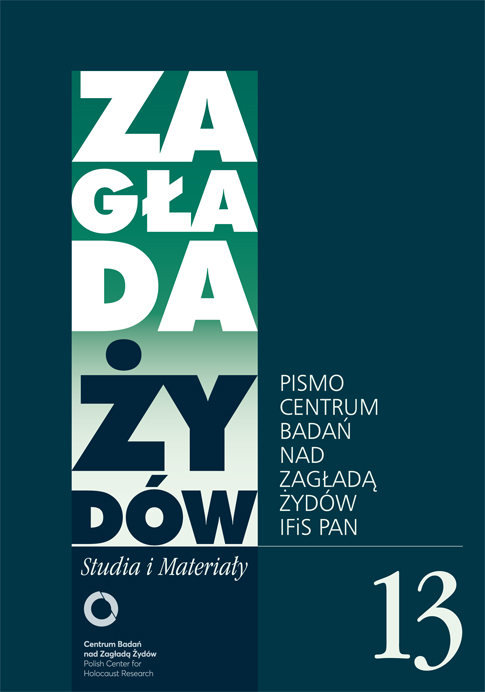Bernard Mark, powstanie w getcie warszawskim i proces Jürgena Stroopa
Zagłada Żydów. Studia i Materiały, Nr 13 (2017), Strony: 181-202
Data zgłoszenia: 2020-10-17Data publikacji: 2017-12-03
 https://doi.org/10.32927/ZZSiM.356
https://doi.org/10.32927/ZZSiM.356
Abstrakt
Jürgen Stroop, the SS general who led the liquidation of the Warsaw Ghetto and the suppression of the Warsaw Ghetto Uprising in April–May 1943, was convicted by a Polish court in 1951 and executed in 1952. Bernard (Ber) Mark (1908–1966), Holocaust historian and director of the Jewish Historical Institute in Warsaw, provided expert testimony for the prosecution at Stroop’s trial. Mark felt constrained to graft a communist-inflected narrative onto his account of the Warsaw Ghetto Uprising and to shoehorn it into his expert testimony in court and then into his interpretation of the trial for a Jewish audience. He did his best to give the Jewish Fighting Organization, which spearheaded the uprising, and its Jewish fighters their due at a time when expression of unvarnished appreciation for Jewish heroism was risky, even while he was paying overrated tribute to the communist underground for its assistance to the Jewish rebels during the uprising. But he always stopped short of the line between conformity to and defiance of the communist regime
Słowa kluczowe
Bernard Mark , Żydowski Instytut Historyczny , powstanie w getcie warszawskim , proces Jürgena Stroopa
Licencja
Prawa autorskie (c) 2017 Autor & "Zagłada Żydów. Studia i Materiały"

Utwór dostępny jest na licencji Creative Commons Uznanie autorstwa 4.0 Międzynarodowe.
https://creativecommons.org/licenses/by/4.0
Inne teksty tego samego autora
- Gabriel Finder, Proces Szepsla Rotholca a polityka kary w następstwie Zagłady , Zagłada Żydów. Studia i Materiały: Nr 2 (2006)
- Gabriel Finder, Svenja Bethke, Dance on the Razor’s Edge:Crime and Punishment in the Nazi Ghettos [Gabriel N. Finder] , Zagłada Żydów. Studia i Materiały: Nr 17 (2021)
Podobne artykuły
- Joanna Tokarska-Bakir, Logika uniku. O protokole audiencji Josepha Tenenbauma u prymasa Augusta Hlonda 3 czerwca 1946 r , Zagłada Żydów. Studia i Materiały: Nr 14 (2018)
- Klara Naszkowska, Judith S. Kestenberg i ucieczka w (nie)pamięć o Zagładzie , Zagłada Żydów. Studia i Materiały: Nr 18 (2022)
- Grażyna Krupińska, Elisa-Maria Hiemer, Autobiographisches Schreiben als ästhetisches Problem. Jüdische Vielfalt in der polnischen und deutschen Gegenwartsliteratur [Grażyna Krupińska] , Zagłada Żydów. Studia i Materiały: Nr 17 (2021)
- Maciej Janowski, Polskie obozy śmierci i polskie dobre imię , Zagłada Żydów. Studia i Materiały: Nr 14 (2018)
- Katarzna Stec, Jolanta Ambrosewicz-Jacobs, Islands of Memory. The Landscape of the (Non)Memory of the Holocaust in Polish Education from 1989 to 2015 [Katarzyna Stec] , Zagłada Żydów. Studia i Materiały: Nr 17 (2021)
- Agnieszka Haska, Sara Kadosh, We Think of you as an Angel: Shaul Weingort and the Rescue of Jews During the Holocaust [Agnieszka Haska] , Zagłada Żydów. Studia i Materiały: Nr 17 (2021)
- Andrzej Leder, Konsekwencje doświadczenia Zagłady dla polskiej świadomości (i nieświadomości) społecznej , Zagłada Żydów. Studia i Materiały: Nr 14 (2018)
- Piotr Filipkowski, Piotr M.A. Cywiński, Auschwitz. Monografia Człowieka [Piotr Filipkowski] , Zagłada Żydów. Studia i Materiały: Nr 17 (2021)
- Elżbieta Janicka, Sąsiedzi raz jeszcze , Zagłada Żydów. Studia i Materiały: Nr 14 (2018)
- Roman Romantsov, Od radzieckiej amnezji do ukraińskiej (nie)pamięci. Zagłada w pamięci kulturowej Ukrainy 1991–2017 , Zagłada Żydów. Studia i Materiały: Nr 14 (2018)
<< < 6 7 8 9 10 11 12 13 14 15 16 17 18 19 20 21 22 23 24 25 26 27 28 29 30 31 32 33 34 35 36 37 38 39 40 41 42 43 44 45 46 47 48 > >>
Możesz również Rozpocznij zaawansowane wyszukiwanie podobieństw dla tego artykułu.
 English
English
 Język Polski
Język Polski



 https://orcid.org/0000-0003-2829-3979
https://orcid.org/0000-0003-2829-3979





